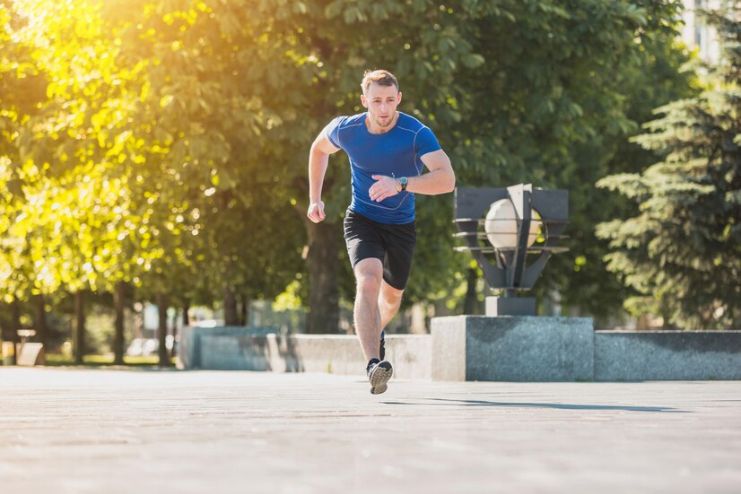AI Contribution
At HealthSpectra, we may use AI to refine grammar and structure, but every piece is shaped, checked, and approved by real people, our expert writers and editors, to ensure clarity, credibility, and care. Learn more..Affiliate Disclaimer
Some links in this article are affiliate links. We may earn a small commission if you make a purchase through these links, at no extra cost to you. We only recommend products we find useful to our readersBreathing techniques play an important role in improving endurance, enhancing performance, and minimizing the risks of fatigue when running. When enough oxygen reaches your muscles, you will have enough energy for the entire run.
In this article, we will explore the best practices for breath control during high-intensity or long-distance runs. We will talk about nasal and mouth breathing patterns, and discuss ways of practicing diaphragmatic breathing for better running.
Nasal vs. Mouth Breathing
The way we breathe through the nose or mouth has a significant impact on athletic performance and overall well-being.
Benefits of Nasal Breathing
- Air Filtration: The nose effectively filters, warms, and humidifies the air, capturing particles, allergens, and microbes. This helps lower the risk of respiratory infections.
- Enhanced Oxygen Intake: Breathing through the nose engages respiratory muscles more efficiently, encouraging deeper, diaphragmatic breathing.
- Better for Endurance: Nasal breathing is effective for endurance activities like running.
- Nitric Oxide Production: Breathing through the nose generates nitric oxide, which improves oxygen delivery throughout the body.
Benefits of Mouth Breathing
- Increased Oxygen Intake: Increases oxygen intake, helping sustain high-intensity exercises like sprints or intervals.
- Eases Breathing: Reduces strain on the nasal passages while running.
- Supports Quick Recovery: Helps flush out carbon dioxide faster and in recovery during runs.
- Limited Benefits: While mouth breathing can be necessary during intense exercise or when nasal passages are blocked, it does not offer the protective benefits of nasal breathing.
Effective Breathing Techniques for Runners

Proper breathing while running goes beyond simply taking deep breaths. It’s about generating a rhythm that enhances lung efficiency and benefits both physical and psychological well-being. Here are some guidelines to help you build effective breathing habits:
- Breathe Nasally: Try to breathe through the nose as much as you can to improve endurance.
- Breathe Through Your Mouth When Necessary: Use mouth breathing during sprints or high-intensity runs to maximize oxygen intake.
- Body Balance Breathing: Modify your breathing rate based on workout intensity to enhance endurance.
- Nasal Breathing Over Mouth Breathing: Intake of oxygen through the nostrils is more effective in providing the body with the necessary oxygen supply. Nasal intake is especially beneficial during cold or dry conditions. Mouth breathing exercises stress respiratory muscles and dry out the airways.
- Diaphragmatic Breathing: Known as “belly breathing, this is one of the most common types of breathing that engages the diaphragm. The diaphragm is the major respiratory muscle that lies below the lungs. Because diaphragmatic breathing results in lung full expansion, it reduces the burden on the chest muscles, neck, and shoulders, making breathing more efficient.
- Rhythmic Breathing: Breathing in sync with each stride can help prevent stress on your body. Try this 5-step pattern: inhale for three strides and exhale for two. The method enhances performance besides making running more controlled.
- Daily Breathing Exercises: Include breathing exercises in daily life to help you breathe easily while running. Some techniques used to ensure effective breathing include box breathing, 7-11 breathing, and Simhasana, or “Lion’s Breath,” which releases stress and enhances oxygen delivery into the muscles. These exercises allow smooth airflow, maintain stamina, reduce fatigue, and provide better control over breathlessness during the run.
- Monitor Air Quality and Lifestyle: Be mindful of environmental factors like poor air quality or allergens that can impact breathing and reduce your endurance. Choose running routes with cleaner air. Adjust your schedule based on air quality forecasts. It will keep your lungs healthy and your breathing efficient.
- Airway Hydration: Hydration keeps your airways moist so they don’t become obstructed and cause breathing difficulty. It is particularly beneficial when you are running during colder months. To hydrate, drink water before and after your run to allow your body to cool down naturally, prevent inflammation in your airways, and breathe easier and more efficiently.
Belly Breathing (Diaphragmatic Breathing)
Belly breathing is also referred to as diaphragmatic breathing. Diaphragmatic breathing works best because it fully contracts the diaphragm, which is the primary muscle located under the lungs. In comparison, with shallow breathing, one can intake more air, thereby maximizing lung efficiency and increasing oxygen uptake for improving running efficiency.
Diaphragmatic breathing makes each breath count in a proper and energy-saving way. This exercise also helps you maintain good posture and can keep a steady rhythm, letting you run longer with less strain on your body.
How to Do Diaphragmatic Breathing
- Stand with relaxed shoulders.
- Place one hand on your chest and the other on your stomach.
- Breathe in through your nose as deeply as possible so your stomach rises rather than your chest.
- Exhale slowly through your mouth for 4-5 seconds.
- Practice breathing in sync with your steps.
- , inhale for three steps, and exhale for three.
- Increase your running pace slowly.
How to Breathe During Long Runs vs. Sprints

Breathing contributes significantly to improving performance and reducing fatigue when running. The techniques you use depend on whether you are doing long runs or sprints.
Long Run Breathing Techniques
- Keep a Steady Rhythm: Maintain a steady, rhythmic breathing pattern to support endurance.
- Combine Nose and Mouth Breathing: This allows you to breathe easily while helping to stabilize your heart rate.
- Diaphragmatic Breathing: Use the diaphragm to breathe more deeply, take in more oxygen, and avoid side stitches.
- Promote Relaxation: Staying relaxed while running can make you more comfortable and improve performance.
Breathing Techniques for Sprints
- Faster and Vigorous Breathing: Sprinting requires rapid breathing, often done through the mouth.
- Brief Shallow Breathing: Aim for deep breaths at a rapid pace to pump oxygen into the muscles when it is most needed.
- Optimized Delivery: Shallow mouth breathing can ensure that your body quickly receives the necessary air to fuel performance.
Breathing Difficulties
- Problematic Signs: Wheezing or chest constriction may indicate that you’re pushing too hard.
- Asthma Considerations: For those with asthma, proactive breathing techniques are important for managing symptoms and enhancing performance.
Common Breathing Mistakes and How to Fix Them
Shallow Chest Breathing
- Mistake: Limits oxygen intake and causes breathlessness.
- Fix: Practice diaphragmatic breathing by inhaling deeply through your nose and allowing your abdomen to expand.
Inconsistent Breathing Patterns
- Mistake: Holding your breath or breathing irregularly during sprints or uphill runs.
- Fix: Establish a rhythmic pattern, such as inhaling for three steps and exhaling for two.
Neglecting to Warm Up Respiratory Muscles
- Mistake: Not preparing your lungs for exercise.
- Fix: Incorporate breathing exercises, like pursed lips or alternate nostril breathing, to enhance lung capacity.
Breathing Solely Through the Nose
- Mistake: May not provide enough oxygen during intense efforts.
- Fix: Switch to mouth breathing during high-intensity runs or sprints for greater airflow.
Forgetting to Monitor Breath During Different Paces
- Mistake: Inconsistent breathing leads to fatigue.
- Fix: Pay attention to your breathing and adjust it according to your running pace to maintain oxygen flow.
Conclusion
Master your breathing techniques while running, as they are the greatest endurance enhancers and overall performance enhancers. First, learn the differences between nasal and mouth breathing; second, adopt other techniques such as diaphragmatic breathing and rhythmic breathing patterns.
Knowing exactly how to adjust your breath to the intensity of running, the long-distance jog versus the sprint will further enhance your running experience.
One can indulge in habits such as belly breathing and specific breathing exercises to increase lung capacity and help manage stress, making running more enjoyable and effective.
Mindful attention to one’s breath and intentional adjustments can help avoid common pitfalls, enhance athletic performance, and support progress toward running goals. Effective breathing, of course, energizes not only the body but also one’s ability to stay focused and connect with the body, enabling stronger, longer, and more effortless running.
References
- https://www.lung.org/blog/you-might-be-breathing-wrong
- https://ace.edu/blog/how-to-destress-simply-by-improving-your-breathing
- https://studentspace.org.uk/wellbeing/7-11-breathing-exercise
- https://www.othership.us/resources/breathwork-exercises
- https://www.healthline.com/health/4-7-8-breathing
- https://www.cuh.nhs.uk/patient-information/breathing-pattern-disorders-and-physiotherapy
- https://www.medicalnewstoday.com/articles/diaphragmatic-breathing
- https://www.healthline.com/health/exercise-fitness
- https://foreverfitscience.com/sprinting/the-biomechanics-of-breathing-during-sprinting
In this Article






















